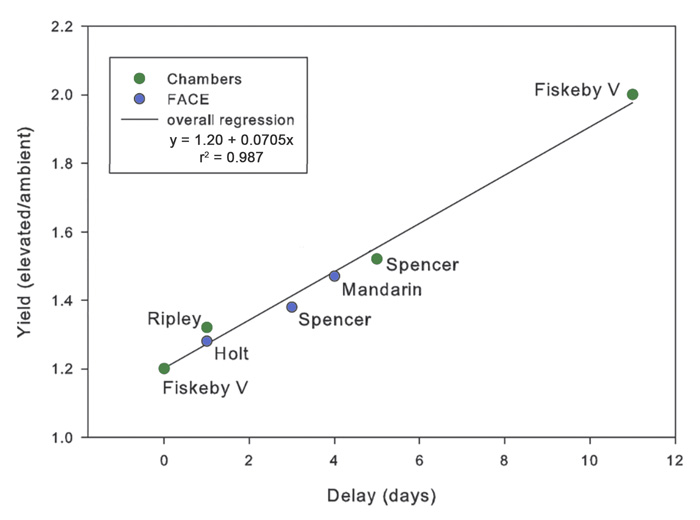| Follow @co2science |
Paper Reviewed
Bunce, J.A. 2015. Elevated carbon dioxide effects on reproductive phenology and seed yield among soybean cultivars. Crop Science 55: 339-343.
Soybean (Glycine max) is one of the top 15 crops grown worldwide. It is a highly prized legume appreciated for its many agricultural and industrial uses. Compared with other major staple food crops, it is exceptionally nutritious; it is high in protein content, calcium, thiamin, dietary fiber, iron, manganese, phosphorus, vitamin C, vitamin K, and several B vitamins. In the future, soybean production is expected to increase. Thus, there is much interest in learning about this important crop and how to increase its seed yield without expending additional costs and resources. And to this end, many scientists continue to study the impacts of rising atmospheric carbon dioxide (CO2) concentrations on soybeans.
In an important work that recently caught our attention, James Bunce -- a USDA researcher from the Crop System and Global Change Laboratory in Beltsville, Maryland, USA -- reports that seed yield increases have been observed by many scientists in soybean plants grown under elevated levels of atmospheric CO2. However, he notes that there are often large response differences among cultivars, the reasons for which "are not clear." In a search for answers, Bunce (2015) therefore set out to conduct his own study to investigate the impacts of elevated CO2 on soybean seed yield. More specifically, he grew three soybean cultivars (Fiskeby V, Ripley and Spencer) from seed to harvest in indoor controlled environment chambers at either 380 or 560 ppm CO2, as well as three cultivars (Mandarin, Holt and Spencer) in an outdoor environment at either 451 or 659 ppm CO2 using free-air CO2 enrichment (FACE) technology. Measurements were made during the course of the growing season in an attempt to determine the cause of seed yield variation among cultivars at enhanced levels of atmospheric CO2. And what did those measurements reveal?
According to Bunce, elevated CO2 stimulated soybean seed yield in all cultivars and experimental conditions between 1.2 and 2 times above that of ambient conditions. In addition, he found there was a "delay in the cessation of vegetative growth caused by elevated CO2 concentration" that varied among the cultivars. This delay, he states, "allowed more nodes to develop [and increased] the number of pods at maturity," such that the longer the CO2-induced delay persisted, the greater was the CO2-induced enhancement of seed yield, as illustrated in the figure below.
With respect to why or how this CO2-induced delay occurs, Bunce writes that the mechanism "is not known." Nevertheless, thanks to Bunce's work we do know that it does occur; and it demonstrates the potential for growers to enhance soybean yields in the future, simply by selecting those cultivars that are most responsive to delaying the transition from vegetative to reproductive growth at higher levels of atmospheric CO2 concentration.

Figure 1. Soybean seed yield at elevated CO2 relative to the yield at ambient CO2 for cultivars grown in indoor chambers (green symbols) and in the field in free-air carbon dioxide enrichment (FACE ) plots (blue symbols) in relation to the delay caused by elevated CO2 in the opening of the first flower at the apical node of the main stem. Names of the cultivars are listed next to their plotted values. The line is the overall linear regression: y = 1.20 + 0.0705 x, with r2 = 0.987. Adapted from Bunce (2015).




